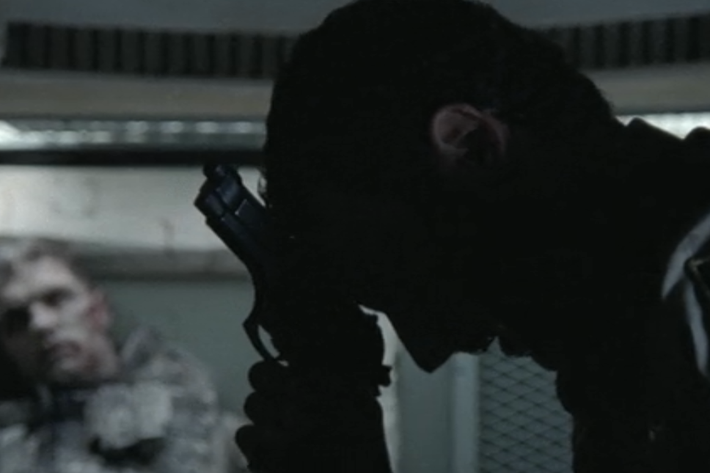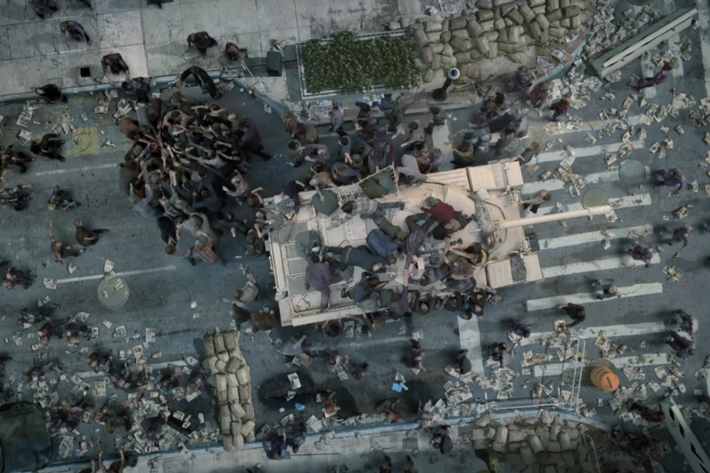
Fear the Walking Dead premiered on AMC Sunday night. The Los Angeles spinoff takes place in loosely the same time frame as The Walking Dead pilot, “Days Gone Bye” (directed by show creator Frank Darabont). More important, it gives us a reason to revisit the original pilot, which launched the monster franchise five years ago and was one of the best TV pilots in recent memory.
So how do the two compare? Let’s say that if it were a zombie, Fear the Walking Dead’s pilot (directed by Adam Davidson) is the lame half-torso of a zombie Rick puts out of its misery in The Walking Dead. They’re both roughly the same length (just over an hour), but with vastly different approaches: The Walking Dead is stylistically similar to Cormac McCarthy’s The Road, whereas Fear the Walking Dead is more like The Grapes of Wrath, if tumbleweeds were replaced with the occasional zombie.
The Talking
Robert Kirkman said that he wanted to make Fear the Walking Dead a family drama first and a zombie show second, and boy, he wasn’t kidding. The meat of the show is about familial tensions, so in lieu of actual walkers, the show gets heavy with spoken references to the impending apocalypse. There’s Tobias, who brings a knife to school to prepare; he’s our little Cassandra of the world, prophesying the future only not to be believed. (“It’s safer in numbers,” he whispers.) Travis Manawa (Cliff Curtis) — father of the family at the center of FTWD — happens to be teaching Jack London’s “How to Start a Fire,” unwittingly getting his students primed for the apocalypse. And who says the humanities aren’t practical?
In The Walking Dead, Rick is the only person onscreen for most of the time, so there’s no one to talk to. Even when Morgan (Lennie James) and his son Duane (Adrian Kali Turner) appear, the dialogue is kept to a bare minimum. Instead, the audience is given context clues to understand that something terrible has happened here. Sure, long monologues would later come along and suffocate the series (ugh, the farm), but as far as the pilot is concerned, it’s unnaturally quiet. If anything, the major flaw of The Walking Dead was that it didn’t allow Rick to live in this world longer.
The Sounds
Related, what’s notable about The Walking Dead is its sound design. Even in the cold-open for Fear the Walking Dead, the score is used heavily to indicate when something undead this way comes. In contrast, there’s no music in The Walking Dead’s first few moments until the frantic strings that signal the start of Bear McCreary’s unsettling theme song and opening credits sequence. For the most part, what we hear are the ambient noises Rick hears: the rubber on the road, swinging signs, birds, until there’s something slightly amiss — a scrape, a creaking doorknob, a groan.
The Cold-Open
One of the major differences between the shows is evident in their cold-opens: the pacing. In The Walking Dead, Rick Grimes, clad in his sheriff uniform, arrives at a wreckage site on the highway looking for gas, and the entire scene plays out slowly and quietly until there’s a sharp turn, when the “little girl” becomes deadly.
Fear the Walking Dead immediately plays up the theatrics — Nick (Frank Dillane) wakes up in a dimly lit crack den to find dead bodies, and soon thereafter, his companion Gloria chowing down on someone else.
The Look
The most obvious difference between the two shows is that The Walking Dead was shot on 16 mm, and Fear the Walking Dead was shot on HD, giving the former a natural grain and grit that lends it a cinematic feel. The shots on Fear the Walking Dead often uses standard medium shots as the characters discuss the banalities of their day. In directing The Walking Dead, Darabont placed the viewer closer to Rick, mixing handheld shots from Rick’s point of view with long shots that eventually panned away far enough to reveal the horror of his surroundings.
Here he is inside a tank, contemplating shooting himself:

Here’s why:

The Acting
Everyone likes Kim Dickens and Cliff Curtis! They are both solidly likable as two sensible, kind-of-cool adults who are just trying to make the best of this crazy world we call high school. If there’s something that really sets apart Fear the Walking Dead, though, it’s Nick (Frank Dillane), their heroin-addict son who looks a little bit like a cross between Skeet Ulrich and Johnny Depp. There’s a comic quality to his character, a bumbling buffoon traversing the world in old-man clothes, that gives the show some levity, whereas The Walking Dead is pretty humorless (okay, the part where Rick is riding a bicycle in his hospital gown is kind of funny). And the best part of rewatching The Walking Dead pilot is remembering that Rick wasn’t always an Über-mensch. He’s a sweaty, pale, post-comatose ball of a man fumbling about as he makes his way out of the hospital. You know, like you or me.




